Papers by Fatima Al Sayah
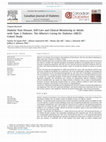
Canadian journal of diabetes, 2015
To examine the prevalence and predictors of foot disease, self-care and clinical monitoring in ad... more To examine the prevalence and predictors of foot disease, self-care and clinical monitoring in adults with type 2 diabetes in Alberta, Canada. Baseline data from a prospective cohort of adults with type 2 diabetes were used. Assessment of foot disease included self-reported peripheral neuropathy, peripheral vasculopathy, foot or leg ulcer/infection or gangrene/amputation. Foot self-care was assessed using the Summary of Diabetes Self-Care Activities, and clinical monitoring using patients' reports of having feet checked for lesions or sensory loss. The mean age of respondents (N=2040) was 64 (SD 10.7) years; 45% were female, and 91% were Caucasian. Peripheral neuropathy was reported by 18% of the respondents, peripheral vasculopathy by 28%, ulcer/infection by 6% and gangrene/amputation by 1.4%. Only 14% of respondents performed foot self-care behaviours ≥6 days per week, and only 41% and 34% had their feet clinically checked for lesions or sensory loss, respectively. Predictors ...
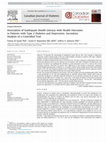
Canadian journal of diabetes, Jan 27, 2015
To examine the relationship of inadequate health literacy (HL) with changes in depressive symptom... more To examine the relationship of inadequate health literacy (HL) with changes in depressive symptoms, health-related quality of life and cardiometabolic outcomes in patients with type 2 diabetes mellitus recently screened positive for depression. Secondary analysis of data from a clinical trial (N=154) that compared a collaborative team care model and enhanced usual care for primary care for patients with type 2 diabetes and depression. The exposure of interest was inadequate HL, defined as a total summative score of 9 or more on the 3 brief screening questions. Outcomes of interest were differences in the changes in depressive symptoms (Patient Health Questionnaire-9 (PHQ-9) at 12 months, health-related quality of life (short-form health survey 12 [SF-12]) and European Quality of Life-5 Dimensions questionnaire (EQ-5D), glycemic control (A1C), low-density lipoprotein cholesterol and systolic blood pressure. The average age of patients was 58 years; 56% were women and were predominant...
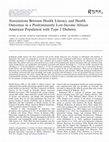
Journal of health communication, Jan 31, 2015
Inadequate health literacy has been associated with poorer health behaviors and outcomes in indiv... more Inadequate health literacy has been associated with poorer health behaviors and outcomes in individuals with diabetes or depression. This study was conducted to examine the associations between inadequate health literacy and behavioral and cardiometabolic parameters in individuals with type 2 diabetes and to explore whether these associations are affected by concurrent depression. The authors used cross-sectional data from a study of 343 predominantly African Americans with type 2 diabetes. Inadequate health literacy was significantly and modestly associated with diabetes knowledge (r = -0.34) but weakly associated with self-efficacy (r = 0.16) and depressive symptoms (r = 0.24). In multivariate regression models, there were no associations between health literacy and A1c, blood pressure, or body mass index or control of any of these parameters. There was no evidence that depression was an effect-modifier of the associations between health literacy and outcomes. Although inadequate ...
Canadian Journal of Diabetes, 2014
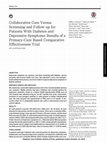
Diabetes care, 2014
Depressive symptoms are common and, when coexisting with diabetes, worsen outcomes and increase h... more Depressive symptoms are common and, when coexisting with diabetes, worsen outcomes and increase health care costs. We evaluated a nurse case-manager-based collaborative primary care team model to improve depressive symptoms in diabetic patients. We conducted a controlled implementation trial in four nonmetropolitan primary care networks. Eligible patients had type 2 diabetes and screened positive for depressive symptoms, based on a Patient Health Questionnaire (PHQ) score of ≥10. Patients were allocated using an "on-off" monthly time series. Intervention consisted of case-managers working 1:1 with patients to deliver individualized care. The main outcome was improvement in PHQ scores at 12 months. A concurrent cohort of 71 comparable patients was used as nonscreened usual care control subjects. Of 1,924 patients screened, 476 (25%) had a PHQ score >10. Of these, 95 were allocated to intervention and 62 to active control. There were no baseline differences between groups...
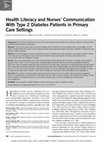
Nursing research
The use of the interactive communication loop has been recommended as an effective method to enha... more The use of the interactive communication loop has been recommended as an effective method to enhance patient understanding and recall of information. The aim of the study was to examine the application of interactive communication loops, use of jargon, and the impact of health literacy (HL) when nurses provide education and counseling to patients with type 2 diabetes in the primary care setting in Alberta, Canada. Encounters between nurses and patients with type 2 diabetes were audio recorded, and a patient survey including a HL measure was administered. Topics within each interaction were coded based on five key components of the communication loop and categories of jargon. Nine nurses participated in this study, and encounters with 36 patients were recorded. A complete communication loop was noted in only 11% of the encounters. Clarifying health information was the most commonly applied component (58% often used), followed by repeating health information (33% often used). Checking...
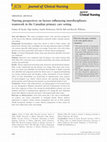
Journal of Clinical Nursing, 2014
Aims and objectives. This study investigated nurses' roles and their perspectives on the factors ... more Aims and objectives. This study investigated nurses' roles and their perspectives on the factors that influence interdisciplinary teamwork within Canadian primary care setting. Background. Interdisciplinary teams have shown to lead to better system-and patient-level outcomes and, accordingly, have became important aspects of healthcare systems especially within primary care settings. Nurses play a key role in these primary care teams, particularly with respect to chronic disease management. Design. A focused ethnography design using semi-structured individual interviews was conducted. Methods. Interviews were conducted with 20 primary care nurses between July 2010-May 2011. Interviews were recorded, transcribed, and content and thematic analysis was performed. Results. Nurses experienced increasing scope of practice and professional responsibility as they transitioned into the primary care setting. Nine major roles of primary care nurses were identified. Several factors that facilitate or hinder teamwork were identified and categorised under four theme areas: (1) organisation/leadership (e.g. having common goals and mandate, unclear descriptions of team members' roles); (2) team relationships (e.g. closed loop of communication, trust, respect);

Health Education & Behavior, 2013
To identify instruments used to measure health literacy and numeracy in people with diabetes; eva... more To identify instruments used to measure health literacy and numeracy in people with diabetes; evaluate their use, measurement scope, and properties; discuss their strengths and weaknesses; and propose the most useful, reliable, and applicable measure for use in research and practice settings. A systematic literature review was conducted to identify the instruments. Nutbeam's domains of health literacy and a diabetes health literacy skill set were used to evaluate the measurement scope of the identified instruments and to evaluate their applicability in people with diabetes. Fifty-six studies were included, from which one diabetes-specific (LAD) and eight generic measures of health literacy (REALM, REALM-R, TOFHLA, s-TOFHLA, NVS, 3-brief SQ, 3-level HL Scale, SILS) and one diabetes-specific (DNT) and two generic measures of numeracy (SNS, WRAT) were identified. These instruments were categorized into direct measures, that is, instruments that assess the performance of individuals on health literacy skills and indirect measures that rely on self-report of these skills. The most commonly used instruments measure selective domains of health literacy, focus mainly on reading and writing skills, and do not address other important skills such as verbal communication, health care system navigation, health-related decision making, and numeracy. The structure, mode, and length of administration and measurement properties were found to affect the applicability of these instruments in clinical and research settings. Indirect self- or clinician-administered measures are the most useful in both clinical and research settings. This review provides an evaluation of available health literacy measures and guidance to practitioners and researchers for selecting the appropriate measures for use in clinical settings and research applications.
Canadian Journal of Diabetes, 2013
OADs (25%) and insulin AE OADs (30%) vs. 1 or 2 OADs (19% to 21%). Withdrawals were mostly due to... more OADs (25%) and insulin AE OADs (30%) vs. 1 or 2 OADs (19% to 21%). Withdrawals were mostly due to gastrointestinal disorders experienced early in the study. In summary, in routine clinical practice, response to liraglutide was greater in patients with shorter duration of diabetes and fewer background treatments.
Canadian Journal of Diabetes, 2013

Arts & Health, 2011
The arts are valued by most societies for a variety of reasons. From a health perspective they ha... more The arts are valued by most societies for a variety of reasons. From a health perspective they have been valued primarily for therapeutic purposes. Subsequently, the benefit of the arts in health research is increasingly evident. Although the arts have been used as a research method in other disciplines, their use in health is much more recent. There is no clear understanding of the kind of arts or the way the arts have been used as a research method. This systematic review of the literature was conducted to fill this knowledge gap. We undertook the review to determine what constitutes arts-based methods in health research and how have these methods been used. We searched eight databases using different combinations of several keywords. We used content and thematic analysis to analyze our results. Thirty studies met our criteria for inclusion. Visual arts were the most common, followed by performance arts, and literary arts. The purposes of using arts in health research were primarily for knowledge production and knowledge translation. Artistic methods are a useful technique for both knowledge production and translation purposes, albeit to a limited degree. We will discuss our findings in terms of trends, methodological issues and theoretical issues. Further research is needed to advance this area of knowledge.

Uploads
Papers by Fatima Al Sayah